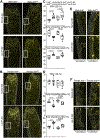Restriction of Dietary Phosphate Ameliorates Skeletal Abnormalities in a Mouse Model for Craniometaphyseal Dysplasia
- PMID: 33463757
- PMCID: PMC9164311
- DOI: 10.1002/jbmr.4110
Restriction of Dietary Phosphate Ameliorates Skeletal Abnormalities in a Mouse Model for Craniometaphyseal Dysplasia
Abstract
Craniometaphyseal dysplasia (CMD), a rare genetic bone disorder, is characterized by lifelong progressive thickening of craniofacial bones and metaphyseal flaring of long bones. The autosomal dominant form of CMD is caused by mutations in the progressive ankylosis gene ANKH (mouse ortholog Ank), encoding a pyrophosphate (PPi) transporter. We previously reported reduced formation and function of osteoblasts and osteoclasts in a knockin (KI) mouse model for CMD (AnkKI/KI) and in CMD patients. We also showed rapid protein degradation of mutant ANK/ANKH. Mutant ANK protein displays reduced PPi transport, which may alter the inorganic phosphate (Pi) and PPi ratio, an important regulatory mechanism for bone mineralization. Here we investigate whether reducing dietary Pi intake can ameliorate the CMD-like skeletal phenotype by comparing male and female Ank+/+ and AnkKI/KI mice exposed to a low (0.3%) and normal (0.7%) Pi diet for 13 weeks from birth. Serum Pi and calcium (Ca) levels were not significantly changed by diet, whereas PTH and 25-hydroxy vitamin D (25-OHD) were decreased by low Pi diet but only in male Ank+/+ mice. Importantly, the 0.3% Pi diet significantly ameliorated mandibular hyperostosis in both sexes of AnkKI/KI mice. A tendency of decreased femoral trabeculation was observed in male and female Ank+/+ mice as well as in male AnkKI/KI mice fed with the 0.3% Pi diet. In contrast, in female AnkKI/KI mice the 0.3% Pi diet resulted in increased metaphyseal trabeculation. This was also the only group that showed increased bone formation rate. Low Pi diet led to increased osteoclast numbers and increased bone resorption in all mice. We conclude that lowering but not depleting dietary Pi delays the development of craniofacial hyperostosis in CMD mice without severely compromising serum levels of Pi, Ca, PTH, and 25-OHD. These findings may have implications for better clinical care of patients with CMD. © 2020 American Society for Bone and Mineral Research.
Keywords: BONE HISTOMORPHOMETRY; BONE QCT/μCT; GENETIC ANIMAL MODELS; OSTEOBLASTS; OSTEOCLASTS.
© 2020 American Society for Bone and Mineral Research.
Conflict of interest statement
Conflict of Interest:
All authors have no conflict of interest.
Figures





Similar articles
-
Dietary phosphate supplement does not rescue skeletal phenotype in a mouse model for craniometaphyseal dysplasia.J Negat Results Biomed. 2016 Oct 26;15(1):18. doi: 10.1186/s12952-016-0061-0. J Negat Results Biomed. 2016. PMID: 27784318 Free PMC article.
-
A Phe377del mutation in ANK leads to impaired osteoblastogenesis and osteoclastogenesis in a mouse model for craniometaphyseal dysplasia (CMD).Hum Mol Genet. 2011 Mar 1;20(5):948-61. doi: 10.1093/hmg/ddq541. Epub 2010 Dec 13. Hum Mol Genet. 2011. PMID: 21149338 Free PMC article.
-
Rapid degradation of progressive ankylosis protein (ANKH) in craniometaphyseal dysplasia.Sci Rep. 2018 Oct 24;8(1):15710. doi: 10.1038/s41598-018-34157-5. Sci Rep. 2018. PMID: 30356088 Free PMC article.
-
[Research Advances of Human Homologue of Mouse Progressive Ankylosis Protein and Bone and Joint Diseases].Zhongguo Yi Xue Ke Xue Yuan Xue Bao. 2021 Apr 28;43(2):293-299. doi: 10.3881/j.issn.1000-503X.12795. Zhongguo Yi Xue Ke Xue Yuan Xue Bao. 2021. PMID: 33966713 Review. Chinese.
-
Role of the progressive ankylosis gene in cartilage mineralization.Curr Opin Rheumatol. 2006 Mar;18(2):181-6. doi: 10.1097/01.bor.0000209432.36355.6e. Curr Opin Rheumatol. 2006. PMID: 16462526 Review.
Cited by
-
Hypophosphatemic rickets: An unexplained early feature of craniometaphyseal dysplasia.Bone Rep. 2023 Aug 17;19:101707. doi: 10.1016/j.bonr.2023.101707. eCollection 2023 Dec. Bone Rep. 2023. PMID: 37654679 Free PMC article.
-
ENPP1 enzyme replacement therapy improves ectopic calcification but does not rescue skeletal phenotype in a mouse model for craniometaphyseal dysplasia.JBMR Plus. 2024 Aug 8;8(9):ziae103. doi: 10.1093/jbmrpl/ziae103. eCollection 2024 Sep. JBMR Plus. 2024. PMID: 39165910 Free PMC article.
-
The Mineralization Regulator ANKH Mediates Cellular Efflux of ATP, Not Pyrophosphate.J Bone Miner Res. 2022 May;37(5):1024-1031. doi: 10.1002/jbmr.4528. Epub 2022 Feb 28. J Bone Miner Res. 2022. PMID: 35147247 Free PMC article.
References
-
- Elcioglu N, Hall CM. Temporal aspects in craniometaphyseal dysplasia: autosomal recessive type. American journal of medical genetics. Mar 19 1998;76(3):245–51. - PubMed
-
- Ramseyer LT, Leonard JC, Stacy TM. - Bone scan findings in craniometaphyseal dysplasia. - Clinical Nuclear Medicine. 1993;18(2):137–9. - PubMed
-
- Nurnberg P, Thiele H, Chandler D, Hohne W, Cunningham ML, Ritter H, et al. Heterozygous mutations in ANKH, the human ortholog of the mouse progressive ankylosis gene, result in craniometaphyseal dysplasia. Nature genetics. May 2001;28(1):37–41. - PubMed
Publication types
MeSH terms
Substances
Supplementary concepts
Grants and funding
LinkOut - more resources
Full Text Sources
Medical
Research Materials
Miscellaneous

